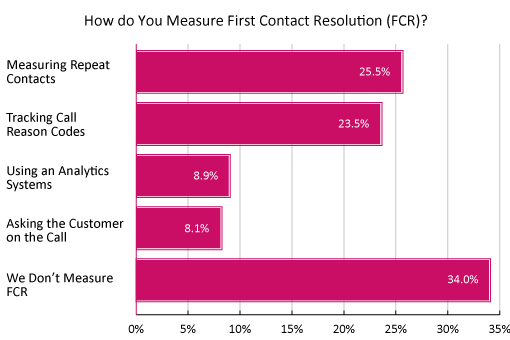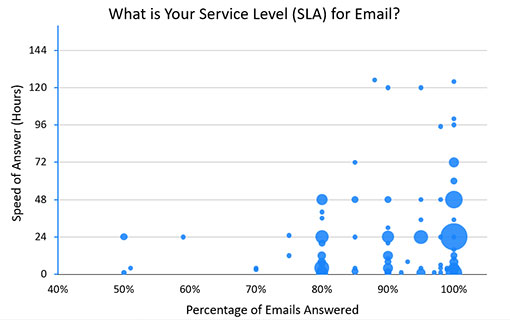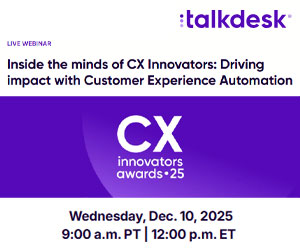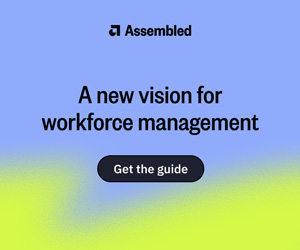For those of you who are looking for quick ideas to improve first call resolution (FCR), we have a video with lots of great tips.
We have also written up these tips below, to help you quickly find the golden advice.
Tips to Improve FCR
In the video below, Jonty Pearce, our Editor, shares his favourite tips for improving FCR.
This video was actually created quite a number of years ago, but many of the teachings remain as relevant as ever.
In fact, since this video was originally published on our YouTube channel, it has had well over 100,000 views.
1. Get Your Measurement Right
You can only manage what you measure. So, the very first step in improving FCR rates in your contact centre is to simply start measuring the metric.
Yet this is easier said than done.
The most common method of measuring FCR is through tracking repeat calls – as shown in the chart below.

However, many would argue that this isn’t a true representation of FCR, because it is difficult to know whether the repeat call was regarding the same issue.
So, please read the following article before you start measuring FCR: How to Calculate First Contact Resolution
2. Consider: Why Did the Customer Call in the First Place?
As much as 50–70% of incoming customer contacts may be generated by a failure within systems and products, as Stephen Parry – a business consultant – once told us.
To eliminate repeat contacts for these issues, many organizations must work backwards to correct the root causes of the problem and develop methods to overcome them.
This will involve lots of communication and cooperation with other departments, so it’s important to nurture strong relationships with the wider company.
For more on fostering these positive relationships, read our article: 7 Clever Ways to Improve Internal Communication Between Departments
3. Start Listening to What Your Callers Are Saying
To understand what is causing callers to call in again and again, there are a few routes that you can take.
One approach is to start listening to calls yourself and identifying, from those calls, what is really going on.
If possible, take a sample of calls, upload them onto your smartphone and start listening to them on the way home. That will give you some idea of why customers call in.
Of course, analysing call reason codes is another approach. Just be sure that advisors are choosing the right codes – you may be surprised how often they just click on anything when given a great list of options!
4. Talk to Your Front-Line Advisors
“What issues to customers usually phone up about time and time again?”
It’s a very simple question to ask your team, but the answers may well shed some light on the problems that are causing low FCR rates.
Your advisors on the phone should have a good idea of what is going wrong, but too often they are an underutilized resource.
For more tips on how to better use your team’s knowledge, read our article: Listen to Your Customers and Staff
5. Set up a Customer Champion Team
A customer champion team is a “task force” that you invite some of your advisors to join.
In many organizations, getting people to join a taskforce is not difficult to do, and in the new work-from-home reality, many advisors will likely jump at the chance of more communication time – albeit virtually – with their colleagues.
One thing that your customer champion team can do is to look at FCR rates across different contact reasons and follow the journeys in which FCR is low. They can then discuss how you can better support the customer in this scenario.
6. Bolster Product Knowledge
By researching your FCR rates, what you will likely uncover are areas in which product knowledge is low. Fortunately, this is one of the easiest areas to fix in the contact centre.
All too often, we put people through an induction programme and – for many contact centres – that’s where an advisor’s product knowledge ends.
To bridge this gap, we then ask team leaders to act as a first-line help-desk – which doesn’t lend well to building advisor confidence in their own performance.
Adding a quality monitoring focus around knowledge gaps, adding e-learning and creating platforms for advisors to share knowledge are all, therefore, great places to start boosting FCR.
7. Start Fixing Broken Processes
This tip is important, but difficult. Why? Well, these broken processes may well be in different parts of the organization.
The first step is to identify where the broken processes are. Then you can start to build teams who are in charge of dealing with that problem.
If they uncover a problem elsewhere, get them to notify the other department and show them how the broken process is hurting the business. It’s also good to tell them how they can benefit from fixing it, to increase their motivation to do so.
8. Rethink the ACD Statistics
In contact centres, we can become very heavily reliant on ACD statistics. The problem with this is that they typically focus on speed, not quality.
However, answering contacts quickly is not necessarily conducive to FCR.
For example, many contact centres focus heavily on service level, so much so that advisors feel pressured to rush off the phone and answer the next call rather than solving the problem.
This can especially be the case with statistics like number of calls in queue, wait time and Average Handling Time (AHT) on advisor dashboards and wallboards.
So, reconsider how you present your ACD statistics and think about what impact this could unconsciously be having on your team.
For more on ACD statistics and reporting them, read our article: A Quick Guide to Call Centre Reporting – With the Top Seven Reports, Examples and Tips
9. Turn Advisors Into Customer Advocates
The whole topic of employee empowerment can be quite vague. But the key is to find opportunities to empower your advisors to do the right things for customers.
One example of doing this is to allow advisors to offer compensation to customers, but you can also ease back on script adherence, reward advisors who come up with new, effective ways to handle difficult contacts and so on.
Many contact centres may be hesitant to move towards empowerment and away from a position of command and control. But just take one idea at a time and see how it impacts FCR.
For more ideas on boosting advisor empowerment, check out our article: What Does Employee Empowerment REALLY Mean?
10. Answer Your Emails Quickly
According to a 2019 Call Centre Helper report, the most common service level target on the email channel was to answer 100% of emails in 24 hours.

But is this really good enough to prevent multiple contacts regarding the same issue?
Many people expect an email response within an hour, so this traditional service level practice may need rethinking. Next-day email is too late.
The least that the company can do is to set customer expectations for when a response will come by sending an automatic reply. They can then add a link for a customer to quickly go through another channel, if they want a quicker response.
11. Build Better Links With Marketing
While building strong links across wider business departments is important, this is particularly important when it comes to marketing.
Quite often, the first thing the contact centre will know about a marketing campaign is when the call volumes start to drive up within the contact centre.
If you can work with marketing to forecast this extra traffic in advance and discuss with agents the types of contact they are likely to expect, you can better handle that influx of calls and improve FCR.
12. Use Speech Analytics Technology
Speech analytics enables you to pinpoint and quantify the number of times that a service problem is happening. This will enable you to build business cases, with the knowledge of how often a problem arrives.
This technology can also enable you to better measure FCR, as it picks up call reasons automatically, making it a much better measure than repeat calls.
With this analysis you can also compare FCR rates across different contact reasons, to identify the areas that need to be addressed first, in order to improve the metric result.
For more on the uses of speech analytics, read our article: 16 of the Best Uses for… Contact Centre Analytics
13. Consider Process Improvement Software
This software has great benefits in allowing you to map out your business processes and identify areas that might be causing problems, in terms of FCR and other customer outcomes.
By mapping out your processes, you can also look at what can be automated, simplified, eliminated or maybe even leveraged, in order to improve customer experience.
A great tool in helping you to do this is the “Value-Irritant Model”, which we introduce in our article: A Simple Technique to Improve Your Contact Centre Strategy
14. Start by Addressing Your Top Three Issues
Many possible initiatives to improve FCR will “spin out” of using analytics and process improvement software, so you need to think about how you can add some sanity to your FCR programme.
As with most things in life, it comes down to prioritizing, and a good tip is to prioritize your top three key initiatives in improving FCR.
These initiatives should either be the quick wins or those that have the biggest impact on the contact centre.
15. Get Some Quick Wins Under Your Belt
If you can highlight a few areas in which you can improve things quickly, that gives some early momentum to your improving FCR programme.
These quick wins help to pull your team together, as you can perhaps go out for a celebration to congratulate yourselves on having made a bit of a difference.
You can then start to go off and work your way down the wish list that you have created – with the help of the previous 14 tips – and spark some real, substantial, positive change.
5 Bonus Tips From Our Readers
To add to all of Jonty’s great tips, we asked our readers to get involved and send in some tried-and-tested methods that they have used to improve FCR.
Fortunately, we received lots of great ideas. Here are our favourite five.
16. Add FCR to Your Quality Assurance (QA) Checks
As part of your QA checks, include “Did you get this right first time?” as a measure. If the assessor believes they didn’t, call the customer back.

By doing this, you avoid another (frustrated) inbound call. It also leaves a great impact on the customer’s impression of the business and makes sure the advisor wants to get it right next time.
Contributed by: Alex
17. Make the Most of Your Call Summaries
Train your advisors to summarize the call and ask the customer if they have any questions about what has been discussed – at the end of every interaction!
Agents should also ask the customer if they have any additional queries they would like to discuss.
Contributed by: Dianne
18. Set Realistic Customer Expectations
Low FCR rates are often a cause of the contact centre not being able to deliver on the expectations being set by marketing and other departments.
You must work together with departments to set the same expectations and goals.
It is equally important to make sure that the customer has understood the next steps that the agent has outlined.
Contributed by: Debbie
Find out more about setting the right customer expectations in our article: How to Manage and Exceed Customer Expectations – With Examples
19. Remove Handling Time Targets
We have removed AHT from the sales teams as we want to make sure we are fully understanding what the customer wants and needs and they are buying what is important to them.
By doing this, we have found that it cuts out on customers calling back to amend the order.
Contributed by: Andrew
20. Analyse Patterns in FCR
Look at analysing FCR by time-of-day/day-of-week. This could highlight key trends that could be preventing you from hitting your FCR targets.
These trends may be about particular shifts, customer patterns or some departments shutting early, preventing the query being resolved. There are lots of things to look into!
Contributed by: Anthony
For more great insights from us and our readers on using FCR in the contact centre, read our articles:
- What Is First Contact Resolution? – With a Definition, Formula and Expert Best Practices
- 33 Tips for First Contact Resolution
- The Difference Between Measuring Repeat Contacts and First Contact Resolution
Author: Jonty Pearce
Reviewed by: Megan Jones
Published On: 3rd Feb 2021 - Last modified: 5th Dec 2025
Read more about - Hints and Tips, Customer Experience (CX), Editor's Picks, First Contact Resolution (FCR), Management Strategies, Service Strategy, Videos











































